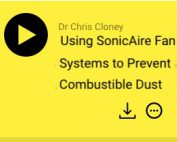Clearing the Aire – SonicAire Blog
Two Industrial Dust Cleaning Standards Every Wood Processing Facility Needs to Address
When you work with wood, sawdust is inevitable. It gathers on nearly every surface, and its build-up can be extremely hazardous. How hazardous? Between 2008 ...
Combustible Lint Control System for Commercial Laundry
When you serve the healthcare industry, best practices for hygiene are imperative. A reputation for clean facilities is central to success. As the premier ...
Industrial Dust Control – 5 Mistakes You May Be Making
Heightened standards for industrial dust control and news coverage of combustible dust incidents have increased the awareness of industrial dust hazards. Yet, some common misconceptions ...
How to Prevent Combustible Dust Accumulation in Overhead Areas – Podcast with Jordan Newton
SonicAire COO and dust safety expert Jordan Newton is interviewed in this Dust Safety Science podcast and answers the following questions: Why should facilities be ...
Dust Control Fans Presentation at Dust Safety Conference
SonicAire’s COO Jordan Newton is a featured speaker at the upcoming Digital Dust Safety Conference sponsored by Dust Safety Science. His presentation, “Using Fan Systems ...
Could Industrial Dust Control Fans Save You Millions?
All it takes is one incident to send every penny of your company’s profits up in smoke ... literally. In seconds, a combustible dust ...
FAQs on Combustible Dust
What is combustible dust, and how does it affect your operations? Discover what you need to know as we answer the most frequently asked ...
Lint and Pathogens: How to Protect Patients and Staff with Overhead Lint Control
Roughly 5 billion pounds of linens are laundered in health care settings each year in the United States. To prevent the spread of pathogens, ...
What Is the True Cost of Combustible Dust?
Webster defines cost as “an amount that has to be paid or spent.” This concise definition describes a simple transaction. I pay x for ...
Combustible Dust Fans Provide Effective Solution for Wood Pellet Manufacturing Challenges
“When it comes to controlling combustible dust, the best practice in the wood pellet manufacturing industry is to contain it,” reports Andy Galis, Operations ...












